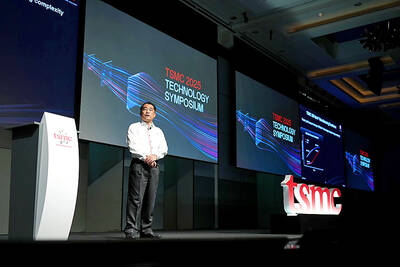With the first quarter's economic growth reaching 6.28 percent, the Chung-Hua Institution for Economic Research (CIER, 中經院) yesterday revised upward its full-year economic growth (GDP) forecast this year to 5.35 percent from the 4.67 percent predicted in April.
"The nation's real GDP is expected to break through the NT$10 trillion level, reaching NT$10.47 trillion in 2004," Chou Ji (周濟), director of CIER's Center for Economic Forecasting, told a press conference yesterday morning.
Chou expressed a bullish view about the local economy, although uncertainties still loom that could possibly cloud future development, he added.
"The nation's economic growth momentum is stable on an uptrend, although the GDP figure in the second half of the year may slightly slide down as a result of a higher base last year," Chou added.
The nation's better-than-expected export and import performance in the second quarter, which respectively grew 28.9 percent and 39.8 percent, and a pick-up in domestic demand, which contributed 5.08 percentage points to the first quarter's 6.28 percent GDP growth, is expected to bring up the nation's GDP rate in the second quarter to an estimated 6.4 percent, according to Chou.
The nation's private investment is also estimated to see positive growth of 29.15 percent in the second quarter, an estimated 21.86 percent growth in the third quarter and an estimated 15.11 percent in the fourth.
But CIER estimated that the nation's GDP figures in the third and fourth quarter may respectively decline to 4.61 percent and 4.27 percent while next year's figures may be even worse, at 4.44 percent.
Chou noted that unforeseen economic uncertainties include the likelihood of the US Federal Reserve raising interest rates, upcoming elections in both the US and here, terrorist threats surrounding the Olympic games in Athens next month, and the aftermath of China's measures to cool its over-heated economy, any of which may have a negative impact on the global and local economies.
Despite the world economy appearing to have emerged from deflationary pressures, CIER president Chen Tien-jy (
CIER estimated that the nation's consumer price index (CPI) may hit 2.1 percent in the third quarter -- the highest since 1999 -- and fall back on 1.35 percent in the fourth quarter.
Chou, however, said that the index's fluctuation is currently in an acceptable level while the New Taiwan dollar still faces pressures to gain between NT$32.8 and NT$33 against the US greenback in the second half year.

DEMOGRAPHICS: Robotics is the most promising answer to looming labor woes, the long-term care system and national contingency response, an official said Taiwan is to launch a five-year plan to boost the robotics industry in a bid to address labor shortages stemming from a declining and aging population, the Executive Yuan said yesterday. The government approved the initiative, dubbed the Smart Robotics Industry Promotion Plan, via executive order, senior officials told a post-Cabinet meeting news conference in Taipei. Taiwan’s population decline would strain the economy and the nation’s ability to care for vulnerable and elderly people, said Peter Hong (洪樂文), who heads the National Science and Technology Council’s (NSTC) Department of Engineering and Technologies. Projections show that the proportion of Taiwanese 65 or older would

Nvidia Corp yesterday unveiled its new high-speed interconnect technology, NVLink Fusion, with Taiwanese application-specific IC (ASIC) designers Alchip Technologies Ltd (世芯) and MediaTek Inc (聯發科) among the first to adopt the technology to help build semi-custom artificial intelligence (AI) infrastructure for hyperscalers. Nvidia has opened its technology to outside users, as hyperscalers and cloud service providers are building their own cost-effective AI chips, or accelerators, used in AI servers by leveraging ASIC firms’ designing capabilities to reduce their dependence on Nvidia. Previously, NVLink technology was only available for Nvidia’s own AI platform. “NVLink Fusion opens Nvidia’s AI platform and rich ecosystem for

Taiwan Semiconductor Manufacturing Co (TSMC, 台積電) yesterday said it is building nine new advanced wafer manufacturing and packaging factories this year, accelerating its expansion amid strong demand for high-performance computing (HPC) and artificial intelligence (AI) applications. The chipmaker built on average five factories per year from 2021 to last year and three from 2017 to 2020, TSMC vice president of advanced technology and mask engineering T.S. Chang (張宗生) said at the company’s annual technology symposium in Hsinchu City. “We are quickening our pace even faster in 2025. We plan to build nine new factories, including eight wafer fabrication plants and one advanced

‘WORLD’S LOSS’: Taiwan’s exclusion robs the world of the benefits it could get from one of the foremost practitioners of disease prevention and public health, Minister Chiu said Taiwan should be allowed to join the World Health Assembly (WHA) as an irreplaceable contributor to global health and disease prevention efforts, Minister of Foreign Affairs Lin Chia-lung (林佳龍) said yesterday. He made the comment at a news conference in Taipei, hours before a Taiwanese delegation was to depart for Geneva, Switzerland, seeking to meet with foreign representatives for a bilateral meeting on the sidelines of the WHA, the WHO’s annual decisionmaking meeting, which would be held from Monday next week to May 27. As of yesterday, Taiwan had yet to receive an invitation. Taiwan has much to offer to the international community’s